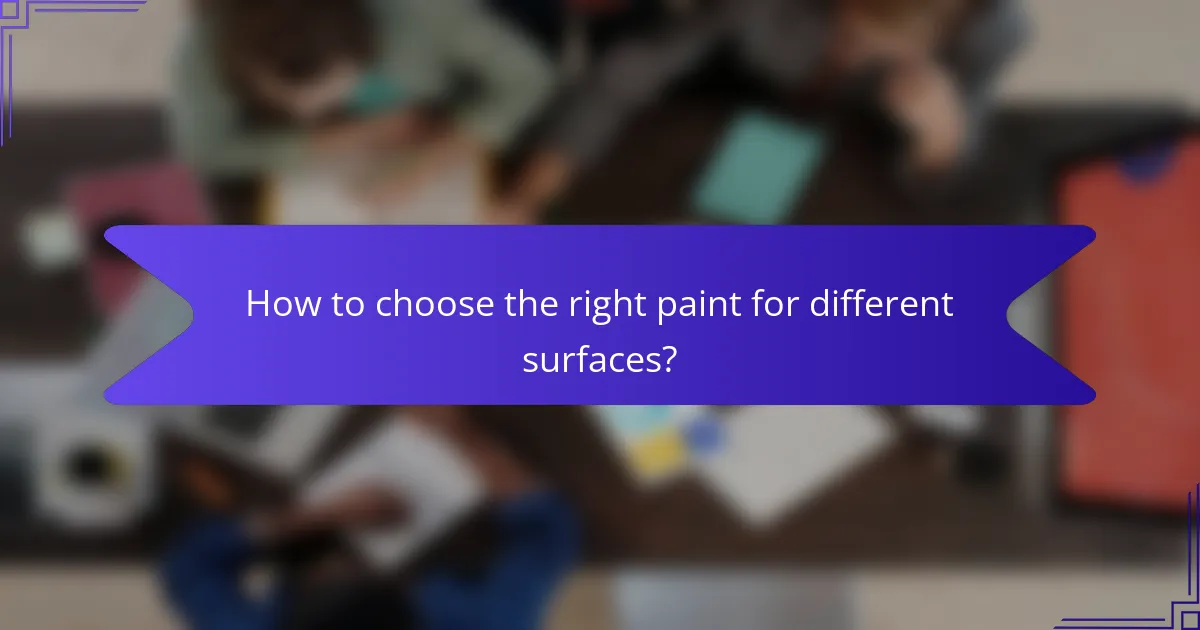Choosing the best paint for home renovation involves understanding the ideal finish, color trends, and application techniques. The right finish can enhance the aesthetic and functionality of different spaces, while trending colors in South Africa emphasize earthy tones and bold accents. Additionally, selecting paint suited to various surfaces requires consideration of durability and ease of application to ensure lasting results.

What is the best paint finish for home renovation?
The best paint finish for home renovation depends on the specific area being painted and its intended use. Generally, finishes range from matte to gloss, each offering unique benefits suited to different environments.
Matte finish for low-traffic areas
Matte finishes are ideal for low-traffic areas such as bedrooms or formal living rooms. They provide a soft, non-reflective surface that can help hide imperfections on walls.
However, matte finishes are less durable and harder to clean than glossier options, so they may not be suitable for areas prone to stains or scuffs. Consider using a washable matte paint if you want a similar look with added durability.
Satin finish for kitchens and bathrooms
Satin finishes are a popular choice for kitchens and bathrooms due to their moderate sheen and washability. They offer a balance between aesthetics and practicality, making them easy to clean while still providing a warm appearance.
This finish is resistant to moisture, which is crucial in areas with high humidity. When selecting a satin paint, look for options specifically designed for high-moisture environments to ensure longevity.
Gloss finish for trim and moldings
Gloss finishes are best suited for trim and moldings, as they create a shiny, reflective surface that highlights architectural details. This finish is highly durable and easy to clean, making it ideal for high-traffic areas.
While gloss paint can be striking, it may also reveal imperfections in the surface beneath. Proper preparation and priming of the trim are essential to achieve a smooth, professional look.
Eggshell finish for living rooms
Eggshell finishes are a versatile choice for living rooms, offering a slight sheen that adds depth without being overly shiny. This finish strikes a balance between matte and satin, making it suitable for moderate traffic areas.
Eggshell paint is relatively easy to clean and can withstand some scrubbing, making it practical for family spaces. When selecting an eggshell finish, consider colors that complement your decor while providing a welcoming atmosphere.

What colors are trending for home renovation in South Africa?
In South Africa, trending colors for home renovation include earthy tones, bold accents, and versatile neutrals. These palettes reflect both the natural landscape and contemporary design preferences, making them popular choices among homeowners.
Earthy tones for a natural look
Earthy tones, such as terracotta, olive green, and warm browns, create a serene and organic atmosphere in homes. These colors resonate with the South African landscape, making them ideal for creating a cohesive indoor-outdoor connection.
When selecting earthy tones, consider the amount of natural light in your space. Lighter shades can brighten a room, while deeper hues may add warmth and intimacy. Pair these colors with natural materials like wood and stone for a harmonious look.
Bold colors for accent walls
Bold colors like deep blues, vibrant reds, and rich yellows can make striking accent walls that draw attention and add character to a room. These hues work well in spaces like living rooms or dining areas, where you want to create a focal point.
To effectively use bold colors, choose one wall to highlight and keep the other walls in neutral shades. This approach allows the bold color to stand out without overwhelming the space. Test samples on the wall to see how they look at different times of the day.
Neutral shades for versatility
Neutral shades, including whites, grays, and beiges, provide a versatile backdrop that complements various decor styles. These colors are perfect for creating a timeless look and can easily adapt to changing trends or personal tastes.
When using neutrals, consider layering textures and materials to add depth and interest. For example, a soft gray wall can be paired with a plush sofa and colorful accessories for a balanced and inviting space. Neutrals also enhance natural light, making rooms feel more spacious.

How to choose the right paint for different surfaces?
Selecting the right paint for various surfaces involves understanding the material’s characteristics and the desired finish. Consider factors such as durability, ease of application, and the specific conditions the surface will face.
Latex paint for drywall
Latex paint is ideal for drywall due to its quick drying time and ease of application. It is water-based, making it easy to clean up with soap and water, and it provides a durable finish that resists fading and yellowing over time.
When choosing latex paint, opt for a flat or eggshell finish for interior walls, as these finishes help hide imperfections. For high-traffic areas, consider a satin or semi-gloss finish for added durability and washability.
Oil-based paint for wood surfaces
Oil-based paint is often preferred for wood surfaces because it penetrates well and provides a hard, durable finish. This type of paint is especially useful for trim, cabinets, and furniture, where a smooth, glossy finish is desired.
Keep in mind that oil-based paints have a longer drying time and require solvents for cleanup. Ensure proper ventilation during application, and consider using a primer for the best adhesion and finish.
Specialty paints for metal and concrete
Specialty paints are designed for specific surfaces like metal and concrete, offering enhanced adhesion and protection. For metal surfaces, look for rust-inhibiting formulations to prevent corrosion, while concrete paints often include sealants to withstand moisture and wear.
When applying specialty paints, surface preparation is crucial. Clean and prime the surface as needed, and follow the manufacturer’s instructions for the best results. Consider using a textured finish for concrete to improve slip resistance in outdoor areas.

What are the application techniques for home paint?
Application techniques for home paint include brushing, rolling, and spraying, each suited for different tasks and surfaces. Choosing the right method can significantly affect the finish and efficiency of your renovation project.
Brushing for detailed work
Brushing is ideal for intricate areas such as trim, moldings, and corners where precision is essential. Use a high-quality brush that matches the paint type—synthetic for latex paints and natural bristles for oil-based paints.
When brushing, apply paint in long, even strokes to avoid streaks and ensure full coverage. A common pitfall is overloading the brush, which can lead to drips and uneven finishes; dip only the bristle tips into the paint.
Rolling for large areas
Rolling is effective for covering large, flat surfaces quickly, such as walls and ceilings. A roller with a suitable nap length (typically 1/4 to 1/2 inch for smooth surfaces and 3/4 inch for textured surfaces) helps achieve an even coat.
To maximize efficiency, load the roller with paint and roll it onto a tray before applying it to the wall. Avoid pressing too hard, as this can cause splatter and uneven application. A common technique is to use a “W” pattern to distribute paint evenly.
Spraying for a smooth finish
Spraying provides a smooth, even finish and is particularly useful for large areas or surfaces with intricate details. This method requires a paint sprayer, which can be airless or HVLP (high volume low pressure), depending on the project needs.
Before spraying, ensure the area is well-prepared and masked to avoid overspray. Maintain a consistent distance from the surface (usually around 12 to 18 inches) and move the sprayer in steady, overlapping strokes. Practice on a scrap surface to refine your technique and avoid common issues like drips or uneven coverage.

What are the prerequisites for painting a home?
Before painting a home, ensure the surfaces are clean, dry, and properly prepared. This includes addressing any damage, choosing the right paint type, and selecting appropriate tools for application.
Surface preparation steps
Start by cleaning the surfaces to remove dirt, grease, and old paint. Use a mixture of water and mild detergent for walls and a suitable solvent for tougher stains. Next, inspect for any damage such as cracks or holes and repair them using spackle or caulk.
Once repairs are made, sand the surfaces to create a smooth finish and improve paint adhesion. After sanding, wipe down the area with a damp cloth to remove dust. Finally, apply a primer if necessary, especially on porous or stained surfaces to ensure even color and coverage.
Choosing the right tools
Selecting the right tools is crucial for achieving a professional finish. For walls, use high-quality brushes and rollers that suit the paint type—synthetic brushes for latex paints and natural bristle brushes for oil-based paints. Rollers with appropriate nap lengths can help cover larger areas efficiently.
Don’t forget essential accessories like painter’s tape for clean edges, drop cloths to protect floors, and trays for easy paint application. Investing in good tools can significantly reduce the time and effort needed for your renovation project.

What are the costs associated with home painting in South Africa?
The costs associated with home painting in South Africa can vary significantly based on factors such as the size of the area, the type of paint used, and labor expenses. Homeowners should budget for both materials and labor to ensure a comprehensive understanding of total costs.
Average cost per square meter
The average cost of painting in South Africa typically ranges from ZAR 50 to ZAR 150 per square meter, depending on the complexity of the job and the quality of materials used. This price often includes both paint and labor, but it’s essential to confirm with contractors what is included in their quotes.
When calculating the total cost, consider the size of the area to be painted. For larger spaces, some contractors may offer discounts, while smaller jobs might incur minimum charges. Always request multiple quotes to compare prices and services.
Cost of premium vs. standard paint
Premium paint in South Africa can cost between ZAR 300 to ZAR 600 per 20-liter bucket, while standard paint typically ranges from ZAR 150 to ZAR 300 for the same quantity. Premium options often provide better coverage, durability, and finish, making them a worthwhile investment for high-traffic areas.
When choosing between premium and standard paint, consider the long-term benefits. While premium paints may have a higher upfront cost, they can reduce the need for frequent repainting, ultimately saving money over time. Evaluate your specific needs and budget before making a decision.

What are the environmental considerations for paint selection?
When selecting paint for home renovation, environmental considerations include the paint’s VOC (volatile organic compounds) levels, sustainability of materials, and overall impact on indoor air quality. Choosing low-VOC or zero-VOC options can significantly reduce harmful emissions and improve the health of your living space.
VOC Levels
VOCs are chemicals that can evaporate into the air and contribute to air pollution and health issues. When selecting paint, look for products labeled as low-VOC or zero-VOC, which typically contain less than 50 grams per liter. This can help minimize indoor air pollution and create a healthier environment for you and your family.
Sustainable Materials
Consider paints made from sustainable materials, such as natural pigments and plant-based oils. These options are often biodegradable and have a lower environmental impact compared to conventional paints. Brands that prioritize sustainability may also offer recycling programs for leftover paint, further reducing waste.
Indoor Air Quality
Indoor air quality can be significantly affected by the type of paint used. Opting for paints with low or no VOCs can help maintain better air quality, especially during and after application. Ensure proper ventilation during painting and allow adequate drying time to minimize exposure to any remaining fumes.
